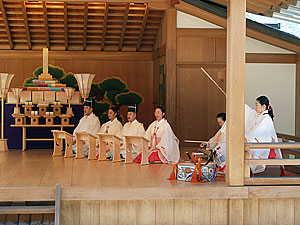
By Bill Roberts
Bill Roberts gave this speech at the Kyoto branch on Dec. 10, 2006. Some explanatory information has been added for non-Oomoto readers.
Konichiwa. Bill Roberts des. Yoroshiku. Onegaishimasu.
Thank you for inviting me to the Kyoto branch. I’ve lost count of the number of Oomoto branches I have visited, but I think it is 15 --- more if you include sub branches.
Most of my previous branch visits were to do research for my book, “A Portrait of Oomoto.” As you know, it was published earlier this year by Tenseisha Press. [Please URL link to chapter on the web site] A Japanese translation is now appearing serially in Matsugokoro, published monthly by the Oomoto Headquarters Youth Division. Each installment is also posted on the Jinrui Aizen-kai home page. [In Japanese version, please URL link to the installments]
Now that the book is published you might wonder why I am still going to branches. There are several reasons I continue to make these visits, talk to Oomoto followers and take photos.
First, there’s always a possibility that I will revise the book in the future. We’re also considering publishing a book of color photos, with a small amount of text and captions in English, Japanese and Esperanto, to explain Oomoto to non-followers.
These visits also continue to expand my own understanding of Oomoto. Even though I wrote a book, I learn new things each time I visit. This is my second trip back to Oomoto since I completed the book a year ago.
Frankly, I am a little embarrassed to only now be visiting your branch. After all, Kameoka is so close and Kyoto plays a key role in the history of Oomoto. I’m not sure why we didn’t visit before now, but I’m glad we finally are here.
Before I share some of my thoughts about Oomoto let me give you a little background.
How I came to Oomoto
I first came to Oomoto in 1999, and started to do some work for the International Department in 2001. My first branch visit was in November 2001, when we went to Hokkaido. We visited the branch in Yamabe and the sub-branch at Toyako. The trip was memorable because we encountered a great deal of snow.
I recently learned that the woman at Oomoto headquarters who made the yukata I wore during the Miroku Odori (summer dance festival) in 2005 is the wife of a man who was born and raised in the sub branch at Toyako. It sometimes seems to me that everyone is related to everyone else at Oomoto.
If you came to the Miroku Odori in 2005 maybe you saw me. I was the one wearing the yukata as big as a Mongolian yurt.
Since my first visit in April 1999, I have spent a total of nearly two years at Oomoto, including 14 months writing the book.
It was Coeleen Kiebert, my ceramics teacher in Santa Cruz, California, who introduced me to Oomoto. She had come here in the mid 1970s after reading “An Encounter with Oomoto,” by Frederick Franck, a writer and an artist who is much better known than me.
Franck saw my book before he died earlier this year at his home in New York. He was in his 90s. I am grateful he saw my book because his book had inspired me. We were both trying to do the same thing: To explain Oomoto to people outside Japan.
After reading Franck’s book, Coeleen was compelled to learn more. When she made a trip to Japan to see a friend, she also managed to contact and arrange a brief visit to Oomoto. Coeleen was attracted to Oomoto because of your approach to the arts. She had long believed that art could and should be done as a spiritual practice, but with rare exceptions she found little support for this way of thinking. In America, art is prized more for its aesthetic or commercial value.
After her brief first visit, Coeleen felt validated for her notion that art could be a spiritual practice for anyone, and from that point on she was able to teach art from a spiritual perspective. In the 1980s, she returned to Oomoto for its traditional arts seminar.
I began to study ceramics with Coeleen in 1998 and came to Oomoto with her in 1999 because I wanted to understand how you use the arts as a spiritual practice. I was also interested in seeing Kyoto.
If you’ve heard any of my earlier speeches or read them on the home page or read my book, you know that my parents met and got married in Tokyo after World War II. My father was here as an Army officer and my mother as a civilian secretary. They had fond memories of their visits to Kyoto during those years.
So I had these two objectives on my first trip: To learn about Oomoto’s approach to the arts and to see Kyoto. I had no idea that first visit was the beginning of a long journey of exploration that would result in writing the book and would challenge many of my own assumptions and beliefs about spiritual matters, including some of my opinions about my own Christian heritage.
There were several reasons I kept coming back. To learn more about the arts was always foremost. But eventually there were other reasons: Your interfaith work, your belief that all religions come from the same source and your commitment to environment and other peaceful causes. I also became fascinated with your rituals, such as Tsukinamisai.
Learning more about all these topics became important to me, and they became important to the book. But I don’t think any one of the aforementioned reasons, or all of them put together, really explains why I kept returning each year. The real reason is, I found fascinating people here: The Foundress, the Co-Founder, the spiritual leaders and just about everyone I interviewed – they all had wonderful spiritual adventures to tell.
As a journalist, I have always been most interested in people. No matter what the subject is – politics, religion, business or baseball – the best journalism is always a story about people. By training, by inclination and by long practice I am perpetually prowling for interesting stories about people.
The people I met at Oomoto – including those I interviewed and the historical figures I got to know through my research -- were all really fascinating people. I want to spend the rest of my time today sharing some reflections on them.
Hidemaru Deguchi: Words for all seasons
Let’s start with Hidemaru Deguchi (1897-1992), the Alternate Spiritual Leader and husband to Naohi Deguchi, the Third Spiritual Leader. Wherever I travel in Oomoto, I find followers who are, in his words, “in search of meaning.” After I read his book by that title – “In Search of Meaning” – I better understood why Hidemaru is one of Oomoto’s central figures. [NOTE: If there is any portio of the book on the home page either Japanese or English section, please put a URL link here to it]
His life story certainly embodies the triumph and the tragedy of Oomoto in its first half century. But his words leap off the page with a timeless quality that speaks to generation after generation.
In interviews for the book, many first-generation followers told me the words of Hidemaru-sensei were one reason they came to Oomoto, and other followers said his words were one reason they stayed at Oomoto.
Hidemaru’s observations are universal and as pertinent today as they were when he wrote them. His words must have been God inspired because they were highly unusual for a young man. I grew up in the 1960s, completed high school and began college in those turbulent years. Hidemaru offers the kind of practical spirituality many of us were seeking during those chaotic times.
You know the details of his life better than I, including the fact that he studied at Kyoto University and it was here in Kyoto where he first encountered Oomoto. Let me skip the biography and discuss his writings that speak to me.
Hidemaru eschews theology and offers a practical approach to living a spiritual life in a crazy world. “Neither spirit nor matter can exist independently of the other,” he advised.
He also wrote: “Only to the extent you put your heart into an effort and become involved can you broaden yourself.” Wherever I go in Oomoto, I encounter followers who put their hearts into their spiritual practice every day.
Hidemaru wrote: “In the very fact that I have been granted life on earth in this manner and moment, I have no doubt that I have some sort of task to complete here. By no means am I here to attain worldly glory and perform brilliant exploits. I believe that one way or another … I must leave behind some mark of my existence for later generations.”
These words certainly ring true for me. I realize God gave me a small writing talent and I need to find ways to give back to society what God has so freely given to me. I am grateful that I can use my writing skills to help Oomoto in some small way. When I pray each morning, I thank God for allowing me to earn a living as a writer and I ask God’s help in directing that talent to some greater good.
Hidemaru emphasized the importance of gratitude and prayer. He wrote: “Being grateful and joyful at all times is the essence of faith.” And he said: “There is no religious life without gratitude and prayer.”
On my early visits to Oomoto I knew little about your interfaith work. I became more knowledgeable each time I returned.
I believe it is no coincidence that just a few weeks after September 11, 2001, I came to Oomoto to do some writing for you for the first time. In the weeks and months after 911, your idea of Bankyo Dokon (“all religions spring from the same root”) began to have real meaning for me. For many years before 911 I had the opinion that religion was more often a source of ill rather than good, and 911 seemed to confirm my belief -- not only the horrific act itself but all the talk afterwards about a clash of civilizations between Christians and Muslims by Americans who should have known better.
By first understanding Bankyo Dokon and then expanding to learn more about the interfaith activities of other religious groups, I began to see that religion could also be a force for good.
Oomoto has most certainly been a force for good. I was deeply impressed by your World Prayer Forum held here in Kyoto in 2002, which I attended and wrote about for the home page.
But good rarely gets the kind of media coverage that evil gets. In writing the book I hoped that in some small way I could redress this imbalance by presenting the interfaith efforts of one religion.
Religious tolerance is essential in today’s world. And your teaching that all religions come from the same origin is the very essence of tolerance. I like what Hidemaru said about this:
“If one truly believes in God one must have a sense of love and respect for everything. However, in this world there are those who take their own religion as the only true faith, and refuse to admit others. There are even extremists who reject other faiths as being heretical. This is a grievous misunderstanding, since it is only natural that religions and denominations vary according to time, place, circumstance, and individual.”
Hidemaru wrote those words 80 years ago, and they are relevant today. So is this: “The world has lost sight of the central point that the universe is created and nurtured by God, and has descended into narrow-minded religion based only on human intellect.”
I conducted two interviews with Hidemaru’s son, Kyotaro Deguchi, and so I know the events that caused the tragedy of Hidemaru’s life. During the second Oomoto incident, when the government cracked down on the sect, Hidemaru was imprisoned and badly tortured.
This tragedy became even more meaningful to me when I visited Takeda, where Naohi took Hidemaru to recover after the mental breakdown he suffered as a result of his torture. If you haven’t been to Takeda you ought to go. Oomoto has many beautiful places but Takeda is one of the most beautiful in my opinion. I attended the annual service there in April 2005.
It was a warm, sunny day, the cherry blossoms were at their peak and the mountains were sprinkled with purple azalea. The day was so pleasant it was easy to forget why Naohi had brought her family there in the first place – for her husband to recover. There were reminders, though.
Throughout the afternoon, followers visited Hidemaru’s room in the granary to pay respects to the memory of this man. When people entered the room, a hush fell over them as in a holy place. As I stood inside the big empty room I noticed people examining a wall. When I joined them, they pointed to scratches in the wood. They were kanji characters by Hidemaru. He had used a nail the way Nao had scratched the words of Ushitora no Konjin on the pillar in her cell. The only characters I recognized were “February,” which made me think of Setsubun.
I left the room and stood outside in the sun, watching people enter and leave. I was emotionally moved as more than one person came out daubing away their tears.
Although he lived in semi-seclusion, Hidemaru was a source of spiritual strength to Naohi when she became Third Spiritual Leader. Kyotaro told me he believes his father had some special way of communicating to Naohi to help her during the nearly four decades that she led Oomoto.
Naohi Deguchi: An infusion of art
By the time I first visited Oomoto in 1999, Naohi (1902-1990) was gone but her name was more prominent to me than the Fourth Spiritual Leader. That was because Naohi was the Spiritual Leader when Franck wrote his book (1977) and when Coeleen came for the arts seminar in the mid-1980s.
As you know, long before she became Spiritual Leader, the young Naohi was immersed in the traditional arts here in Kyoto, working with some of the best teachers the city had at the time. It was Onisaburo who said art is a Way for everyone to God, but it was Naohi who infused Oomoto with art practice, especially tea ceremony and Noh. Onisaburo had revived the Utamatsuri (sacred poetry festival) in 1935, but it became a regular event under Naohi.
Last April when your branch performed its Utamatsuri, I was at home in California, but I watched some of the festival thanks to streaming video on the Internet. Onisaburo would love the Web!
About two years ago I attended a full Noh performance in the theater where you staged the poetry festival. I saw “Eguchi.”
I know that “Eguchi” is considered one of the more beautiful Noh dramas, but to be honest I did not find it spellbinding. I would not recommend it for a first time Noh goer. At the Miroku Noh in 2005, I saw “Kurama Tengu,” which I think might be one of the best Noh dramas for a novice like me to see. The characters and the action were all pretty lively and interesting. Or maybe I liked it because there’s a bit of the goblin in me.
In my interviews, many elderly Oomoto followers said they had made a lifetime practice of shimai or utai or both because Naohi had urged them to do so. One man from Nagoya said he had only been practicing utai for about a year when he was asked to join the chorus for Naohi’s performance of “Hagoromo” at Atsuta Shrine in 1960. It was one of the highlights of his life, he said.
I am impressed by the impact Naohi had on people through the arts. I met two followers who told me they were headed for trouble in their young lives until Naohi sat them down and strongly urged them to study tea ceremony. Tea changed their lives for the better.
I think it is fair to conclude that three generations of followers got involved in tea, Noh, tanka, calligraphy, budo and the other arts because of Naohi.
Kiyoko Deguchi: Emphasis on nature
The first time I visited Oomoto, Kiyoko (1935-2001) was still the Spiritual Leader. I never met her, but I interviewed many people who knew her. For example, one of my colleagues in the International Department was her driver for many years.
Even though I did not meet the Fourth Spiritual Leader, I felt like I knew her indirectly through the stories of others. An accomplished artist in her own right, she practiced Noh and taught yakumogoto. But I associate her more with nature. The importance of nature is another aspect of Oomoto that did not become entirely clear to me until I had visited several times. In particular, the importance you place on working for harmony between humans and nature, which is a theme throughout Shinto. For me, Kiyoko epitomizes this aspect.
Last weekend (Dec. 3, 2006) I went to the Hokuriku branch near Kanazawa, another place you should visit if you have not. The parcel of land, called Shinsei-en, is just a bit smaller than Tenonkyo, covered in trees with a large beautiful pond. It was appropriate that while I was there, I had a chance to look at the new book of Kiyoko’s nature writings.
This book was in preparation during the time I was writing my book. I don’t read Japanese, but you don’t have to in order to appreciate the book. The color photos of flowers and plants are tremendous, the water color pictures are delightful, and it is clear a lot of love went into editing the book. I was told the writings are from Kiyoko’s field notes. As you know, she helped start the botanical garden at Tenonkyo and was a highly accomplished amateur botanist. The people at Hokuriku plan to eventually have a botanical garden there.
Like Hidemaru, Kiyoko went to university in Kyoto, and for that matter so did the Fifth Spiritual Leader.
To my way of thinking, Kiyoko’s emphasis on nature was one of her important legacies.
Oomoto honors the sacred in nature in many ways, especially through its rituals. I am not aware of any ritual in the Judeo-Christian tradition that exalts the sacredness of daikon or Chinese cabbage by blessing them on the altar like you do in kensen (offering) at Tsukinamisai (monthly service).
The connection between nature and Oomoto ritual resonates deep in my inner being. That’s because I understood the spiritual value of nature long before I encountered Oomoto, and long before I understood the spiritual value of art. For 15 years beginning at age 10, I spent a great deal of time hiking and exploring mountains and forests. I always felt at home in the mountains and I felt special spirits there that I would later equate to your kami (divinities). In these wild places I felt the presence of God much more than in the Methodist Church of my youth. When Shinto says there is kami in all natural things, I understand it deep in my bones. Your rituals help followers make the connection between kami and nature.
As I have noted, many followers I interviewed had known Naohi and Kiyoko. I was also delighted that we found at least a few older followers who had known Co-Founder Onisaburo (1871-1948) and Second Spiritual Leader Sumiko (1882-1952).
A retired innkeeper in Tottori remembered helping Sumiko with her Tsuruyama-ori in Ayabe right after the war, when he was still a young man. A 90-year-old woman in Izumo remembered Onisaburo inspecting the publishing office at Tenonkyo, where she worked before the second incident, helping to bind each new volume of the Reikai Monogotari. Onisaburo gave her one of his sumi-e paintings when she returned to Izumo to get married.
Nao Deguchi: A very personal encounter
Stories like these made my book rich in detail. But I knew there was no one still alive who had known Co-Foundress Nao Deguchi (1837-1918). Fortunately, I had my own personal encounter with her – of sorts.
Wherever I went in Oomoto I kept seeing this photo of Nao. You know which one I mean. Taken toward the end of her life, she sits on her knees, humble but stately, dressed in a plain kimono closed by a piece of rope tied in a square knot. She appears serene, her face creased with age. Her eyes are filled with compassion, reassuring us that everything is in God’s hands.
Whenever I see this photo Nao seems to look straight at me. Her eyes seem to follow me wherever I go. It turns out I am not the only one thus affected by this photo.
Yoshio Hori, the branch chief in Nagoya, told me about the impact that photo had on him. He first saw it when he was a teenager and his mother invited a missionary to come talk to the family about Oomoto. His mother soon joined, but he did not join Oomoto for more than a decade. However, he could never get that image of Nao out of his mind. He, too, felt like she was watching him.
I must be honest. When I first heard the story of Nao I found it hard to believe. The spirit possession, the automatic writing -- “You must be kidding,” I said to myself. I had the same reaction to Onisaburo’s travels in the spirit world. My rational and journalistic mind had a hard time accepting these stories.
But I was intrigued by the fact that the story of Nao and Onisaburo was relatively recent. By comparison, the foundational stories in the Judeo-Christian tradition are 2,000 years and older. The New Testament of the Bible tells the story of Jesus and the early Christians. But Jesus wrote nothing and there is not a single word written by anyone who actually knew him. All the accounts were written two or three generations later. For centuries, scholars have disputed the accuracy and authenticity of these accounts.
As a result of my research I became confident that the story of Nao and Onisaburo is authentic and accurate. It was not until I began to work in earnest on the book that I dug deep into Oomoto’s writings and the outside scholarship. Besides Nao’s Ofudesaki and Onisaburo’s writings, I found a considerable amount of research by Japanese and Western scholars – religious historians, anthropologists and others. Each seems to interpret the importance of what happened differently, but they all confirm the facts – Nao’s spirit possession, her automatic writing, and Onisaburo’s spirit journey.
Because I wanted to draw comparisons for my Western audience, I expanded my reading to include scholarly work on the Biblical prophets, Christian mystics and others. What struck me were the remarkable similarities between the experiences of Nao and Onisaburo and mystics from other places and other times. There are many examples, but let me mention one.
Saint Teresa of Avila was a Spanish Catholic nun in the 16th century whose writings are still widely read in the West. Like Nao, she was possessed by a holy spirit. She first resisted it, thinking she was being taken over by the devil.
Teresa also did automatic writing. Although not illiterate like Nao, she admitted that she barely understood some of the writing and felt like a parrot for the spirit that possessed her. Like Nao, Teresa started a new religious group: the Carmelite order of nuns.
To make a long story short, I came to believe the story of Nao pretty much as it is reported. For me it helped that it was so recent and there is excellent documentation by Nao and Onisaburo and research by others that corroborates these events.
Something happened I did not expect. I not only found myself able to accept the stories of Nao and Onisaburo, I began to see more credibility in the stories about Biblical prophets, New Testament miracles by Jesus, and Christian, Jewish and Islamic mystics. The Oomoto story caused me to re-evaluate and bring a more open mind to the possibility of there being truth in these earlier events.
I’ve traveled a lot and when I do I not only learn about the places I visit but I gain new insights into my own country and culture. Something analogous has happened to me during this spiritual journey of writing about Oomoto.
The poet T.S. Elliot said something pertinent to this. Elliot was an American who lived most of his life in Britain and won the Nobel Prize for Literature in 1948. He was deeply religious and a spiritual seeker in his own way.
In one of his better known poems he wrote the following lines about the process of spiritual seeking: “We shall not cease from exploration and the end of all our exploring will be to arrive where we started and know the place for the first time.”
In closing, let me say that through my exploration, my own search for meaning, I have not only come to know Oomoto, I have begun to know the place where I started – that is my own Judeo-Christian tradition – much better for the first time. For this I am grateful.
Kyo-wa watashino hanashi-o. O-kiki kudasari. Arrigato gozaimashta.
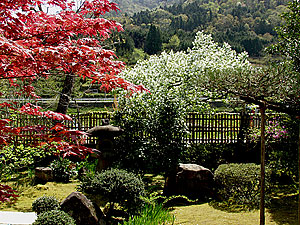
Takeda decked out in spring color.
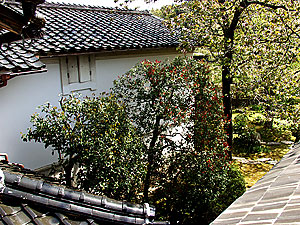
The granary where Hidemaru lived.
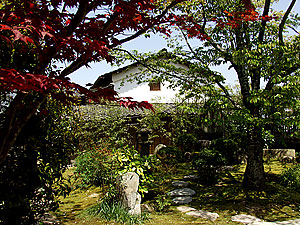
After being tortured by the Japanese authorities, Naohi brought her family here for Hidemaru to recover.
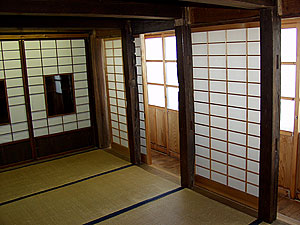
Here is Hidemaru’s room in the granary.
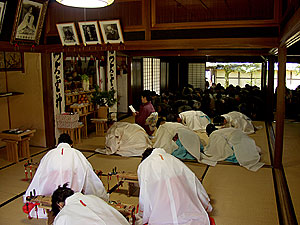
At least once a year, the Spiritual Leader visits and leads a service at Takeda.
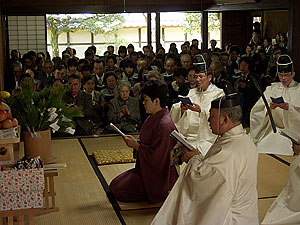
Takeda is an 400-year-old farmhouse.
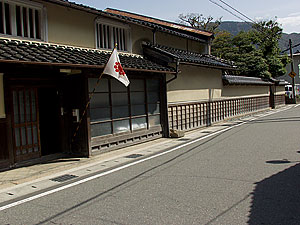
Here is the entrance to the Takeda shrine.
New Contents Thu, May 20, 2010
- Oomoto participates in Sant’Egidio conference : Dialogue among religions and cultures : On divided island nation of Cyprus By Bill Roberts
- Photo Album : Portraits of three branches: Shoko, Tanegashima and Aomori By Bill Roberts
- Oomoto FAQ
- A Letter from Oomoto : Of mountains and myths By Bill Roberts
- Polyglot poem festival The Utamasturi is going international — what’s next? By Bill Roberts
- Ethics education program captures the spirit of Bankyo Dokon By Bill Roberts
- A Letter from Oomoto : A year’s worth of adventure in a summer of branch visits By Bill Roberts
- In Kumamoto, it’s all about water – and fire By Bill Roberts
- A speech by Nevada Taylor at the Kii Branch in Wakayama Prefecture on April 13, 2008.:An Encounter With Oomoto Through Aikido
- Utamatsuri, Poem Festival, in Tokyo(on April 17, 2008)
- A speech by Neil Ryan Walsh at the Kobe branch on Mar. 9th, 2008.:Planting the Seeds of the Soul
- Meeting with the Fifth Spiritual Leader of Oomoto, Madame Kurenai Deguchi by Neil Ryan Walsh
- A speech by Neil Ryan Walsh at the Nagoya branch on Feb. 17th, 2008.:The Japanese Arts beyond National Boundaries
- To the Oomoto branch in Nagoya: City of Eel and Toyota by Neil Ryan Walsh
- A Speech by Nissim Ben Shitrit, Ambassador of Israel on the occasion of the Oomoto Setsubun Grand Festival in Ayabe February 3rd, 2008 : Japan and Israel : Two Lands Balancing the Needs of Traditional Culture and Modern Life. r
- A permanent memorial to Onisaburo (A Speech at the Autumn Grand Festival , November 6, 2007 : )By James Parks Morton, Founder and Chair, Emeritus of The Interfaith Center of New York
- Israel, Palestine and the Power of Poetry(Oomoto believes small efforts can have lasting ripple effects on people and peace)By Bill Roberts
- “Something Great”(This genetics pioneer, a friend of Oomoto, offers a clue to the mystery of life)By Bill Roberts
- Kamishima Cleanup (Harima branch members regularly visit this sacred island to keep the shrine tidy)By Bill Roberts
- Kyotaro Deguchi was one of six recipients of the 2007 James Parks Morton Interfaith Award
What is Oomoto?
- What is Oomoto?
- Spirtual Centers
- Founders and Spiritual Leaders
- History
- Organization and activities
- Teachings and scriptures
- Art Works of Founders and Leaders
Opinions[Archive]
- Statement of regret for the outbreak of war against Iraq (March 20,2003)
- Jinrui Aizenkai dispatched the "Urgent Appeal for a World (Global) Crisis" on March 14.
Grappling with Bioethics[Archive]
- Oomoto’s support for abolishing the death penalty (12, June 2003)
- The Oomoto Foundation protests any birth of a human clone baby. (5, January 2003)
- OOMOTO'S VIEW REGARDING JAPAN’S PERMITION TO THE RESERCH OF HUMAN EMBRYONIC STEM CELLS (ES cells)(12, June 2000)
Vistor’s Review[Archive]
- A speech by Bill Roberts at the Oomoto branch in Hiroshima after its monthly service on March 18, 2007:Encounters with war and peace
- How Bankyo Dokon changed one life by Linda Macphee
- A speech by Bill Roberts at the Hokuriku (Kanazawa) branch on Dec. 3, 2006:Ritual and myth -an encounter with ‘divine madness’
- A speech by Bill Roberts at the Himeji Cultural Center on Feb. 25, 2007:Mesmerized by the Japanese Arts
- A speech by Bill Roberts at the Kobe branch on Feb. 11th, 2007.:There are just human tears and human joy
- A Speech on the occasion of the Oomoto Setsubun Grand Festival in Ayabe February 3rd, 2007 : Egypt's role in Middle East peace
- Keynote Speech for the 28th World Federation Japanese Religionists Conference for World Peace in Tokyo (at Kokugakuin University, Novermber 29, 2006):Vision for Peace in the Middle East By Dr. Munther S. Dajani, Professor Dean, Faculty of Arts, Al Quds University, Jerusalem
- A speech to the Kyoto branch:Spiritual adventures in researching Oomoto leaders
- A Speech at The Oomoto Foundation on Monday, November 6, 2006 : Jordan's role in Middle East By Samir Nouri, Ambassador of the Hashemite Kingdom of Jordan
- A letter from Oomoto:The Young People of Tottori
- A speech by Bill Roberts on the occasion of the dedication ceremony for the new shrine of Tottori Branch By Bill Roberts Oct. 8, 2006
- A speech by Bill Roberts at the Oomoto branch in Hiroshima after its monthly service on March 18, 2007:Encounters with war and peace
- How Bankyo Dokon changed one life by Linda Macphee
- A speech at Setsubun : A Portrait of Oomoto By Bill Roberts Feb. 3, 2006
- New Publication ! By Bill Roberts Feb. 3, 2006 A Portrait of Oomoto
you can read this book in html => http://www.jinruiaizenkai.jp/English/en-kolumno/en-bill/en-sugao/billbook1en.html
E-mail below to order brobert1@ix.netcom.com
Current Topics
- Prayer Offering and World Religious Forum II
- Living the art of dialogue
- Kyotaro Deguchi was one of six recipients of the 2007 James Parks Morton Interfaith Award
Books
Online Books
- Divine Signposts by Onisaburo DEGUCHI
- The Creation of Meaning by Hidemaru Deguchi
- Bankyo Dokon(Seventy years of Inter-Religious Activity at Oomoto)
- Nao Deguchi — A Biography of the Foundress of Oomoto
- The Great Onisaburo Deguchi published by Aiki News
- Bankyo Dokon Seventy Years of Inter-Religious Activity at Oomoto
- Insearch of Meaning
- Nao Deguchi A Biography of the Foundress of Oomoto
- A Portrait of Oomoto By Bill Roberts
Oomoto international Archive
- The History of Oomoto (Jan.– Mar. 1980 — Apr.– Jun. 1982)
- The Ancestors; Friends or Foes? (Apr.– Jun. 1987)
- Tsukinamisai; The Sabbath of Shinto (Jan.– Jun. 1983)
- The Poem Festival at Oomoto; An Ancient Rite Lives Again (Oct.– Dec. 1981)
- Purification of the Universe ; Oomoto's Setsubun Festival (Apr.– Jun. 1981)
Links
Flowers at Ten'on-kyo & Baisho-en (photographs)
Contact
All rights reserved : the Oomoto Foundation Produced by the Netinformational Commission
Since : Mar. 7.1998 Last Update : Thu, May 20, 2010
E-mail : webmaster@oomoto.or.jp
Top Page Nihongo Esperanto Português Roomazi



